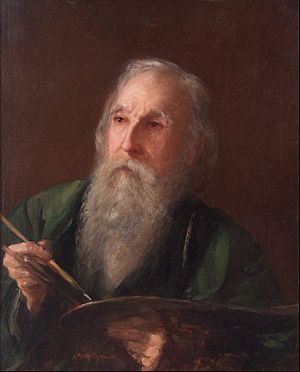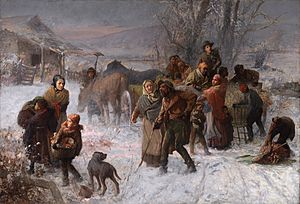Charles T. Webber facts for kids

Charles T. Webber (born December 31, 1825 – died April 5, 1911) was an American painter. He created many paintings during his life. These included portraits, landscapes, and historical scenes. He also painted everyday life. Webber was very active in the art world of Cincinnati. He started many art groups. He was also an important person in the Underground Railroad. People in Cincinnati respected him greatly for his art.
Contents
Biography
Early Life and Learning to Paint
Charles T. Webber was born in Cayuga Lake, New York. This was on December 25, 1825. As a child, he learned to paint and draw. He used a woodshed attic as his art studio. Webber never had formal art training when he was young. Not much else is known about his childhood.
Starting His Art Career
In 1844, Webber moved to Springfield, Ohio. There, he met another artist named John Peter Frankenstein. Frankenstein became Webber's only art teacher. He taught Webber how to paint. After learning these skills, Webber earned a living. He taught art to his own students. He also painted many portraits.
In 1858, Webber moved to Covington, Kentucky. He worked in David R. Hoag’s Cincinnati studio. His job was to add color to photographs. Later, Webber opened a business called Artists’ Photographic and Picture Gallery. His partners were artists Joseph Oriel Eaton and James Mullen. They sold portraits and photographs. The business was doing well. But the American Civil War started in 1861. This caused the business to close. Webber then opened his own art studio. It was at 14 East Fourth Street. He stayed there, painting portraits, until the 1880s.
Webber joined many art groups in Cincinnati. This helped him become a well-known art teacher. He became a very important person in Cincinnati's art scene. In 1878, Webber started teaching at the Ohio Mechanics Institute School of Design. He taught a life class there.
Later Years and Legacy
In his later years, Webber learned to sculpt. In 1896, he made a bronze statue. It was a bust of H. Thane Miller. Miller was the director of the Cincinnati House of Refuge.
Webber passed away in 1911. He was 85 years old. He died at his home in Riverside, Cincinnati. He is buried in an unmarked grave. This grave is at Spring Grove Cemetery. After he died, his artist friends wanted to buy one of his paintings. It was called ‘The Underground Railroad’. They wanted it for the Cincinnati Art Museum. They raised money to buy it. This showed how much Webber was respected. He had a great reputation in the art world.
Helping the Underground Railroad
Webber's most famous work related to the Underground Railroad is his painting. It is also called The Underground Railroad. He finished this painting in 1893. It was for the World's Columbian Exposition that year. The painting shows people escaping to freedom. They are being led by abolitionists. These are people who wanted to end slavery.
The people in the painting were friends of Webber. They included Hannah Haddock, Levi Coffin, and his wife, Catharine Coffin. Levi Coffin was a very famous abolitionist. This painting is special. It focuses on the abolitionists. They helped enslaved people from the South reach freedom in the North. It does not focus on the enslaved people themselves or those who chased them.
Making Cincinnati an Art City
Webber helped Cincinnati become a center for art. He was involved in many art groups.
He helped with the Cincinnati Academy of Fine Arts. This group started in 1838. They wanted better places for artists to work. They also put on art shows. Charles T. Webber helped organize a big art show. It featured American and European art.
Webber was also part of Cincinnati's Sketch Club. He said the club started simply. Members got along well. But then, wealthy people joined. This led to the club ending. Their last meeting was in 1864. The Sketch Club greatly influenced Cincinnati's artists. It also shaped the city's art scene.
In 1866, Webber helped start a group. It was called Associated Artists of Cincinnati. This group included both new and experienced artists. Their goal was to make Cincinnati "the Art-center of the Great West." They also wanted to start an art school. This school would help people in Cincinnati understand art better. Webber was chosen as the President of this group. Their first art show was on December 22, 1866. It showed works by artists like Thomas D. Jones and Henry Mosler. In 1868, this group joined with the Cincinnati Academy of Fine Arts.
By the 1890s, Webber was seen as the most important artist in Cincinnati. He stayed active in the art community until he died in 1911.
Famous Paintings by Webber
Webber created several important paintings. These helped him become popular among other artists.
His most famous painting is Underground Railroad. He painted it for the 1893 World's Columbian Exposition. You can see this painting today. It is at the Cincinnati Art Museum.
Another painting is Portrait of a Boy. Webber painted this oil painting in 1868. At that time, he worked in a portrait gallery in Cincinnati. He sold portraits there. Clients could have their picture taken. Or they could sit for him to paint them. The boy in this painting looks happy. This suggests he sat for Webber. This painting is now at the Smithsonian American Art Museum.
Webber's Achievements
Webber achieved many things in his art career.
In 1870, he convinced the organizers of the first Cincinnati Industrial Exposition to show his art. His art won a silver medal at this event.
His paintings were shown in the Paris Salon exhibition in 1881. This was because he was well-known in Cincinnati. He also knew other famous artists.
Webber's painting, Underground Railroad, was shown at the Chicago World's Exposition in 1893.


